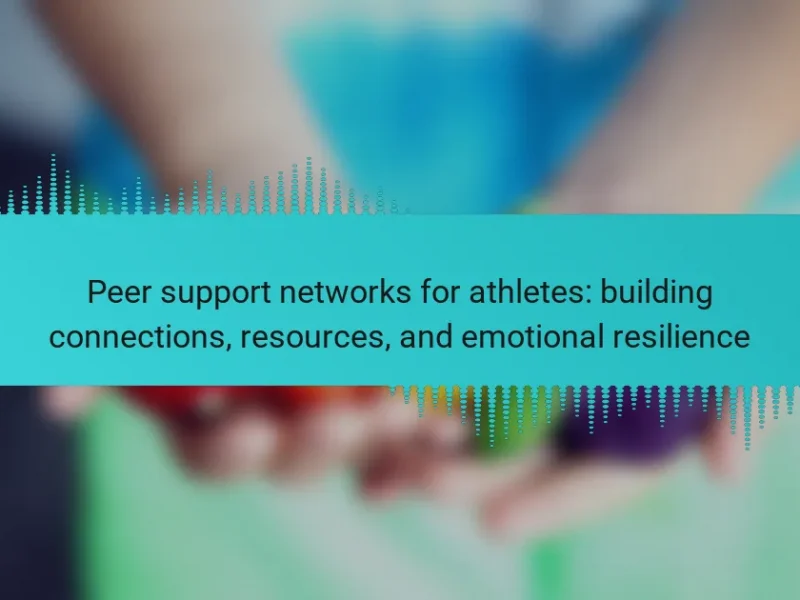Mindfulness techniques enhance athletic performance by improving focus and reducing anxiety. This article explores the benefits of mindfulness practices, such as visualization and breath control, and highlights the importance of community support systems. Athletes can cultivate mental resilience through consistent practice and engagement with peer groups and workshops. These strategies promote recovery and foster a positive environment for growth in sports.

What are the core benefits of mindfulness techniques for athletes?
Mindfulness techniques enhance athletes’ performance by improving focus, reducing anxiety, and promoting recovery. These benefits lead to better training results and competitive outcomes. Regular practice cultivates mental resilience, allowing athletes to manage stress effectively. Engaging with a supportive community further amplifies these advantages, fostering shared experiences and motivation.
How does mindfulness enhance athletic performance?
Mindfulness enhances athletic performance by improving focus, reducing anxiety, and increasing resilience. Athletes practicing mindfulness techniques report better emotional regulation and improved concentration during competitions. Techniques such as meditation, breathing exercises, and body awareness foster a positive mental state, enabling athletes to perform at their best. Community support through group practices enhances motivation and accountability, creating a shared environment for growth and development.
What psychological advantages do athletes gain from mindfulness?
Athletes gain improved focus, reduced anxiety, and enhanced emotional regulation through mindfulness. These psychological advantages lead to better performance under pressure and increased resilience. Mindfulness practices, such as meditation and breathing exercises, help athletes cultivate these benefits. Community support from fellow athletes further reinforces mindfulness, creating a positive environment for personal growth and mental well-being.
How can mindfulness techniques reduce injury recovery time?
Mindfulness techniques can significantly reduce injury recovery time by enhancing mental resilience and promoting relaxation. These techniques help athletes manage pain, reduce stress, and improve focus during rehabilitation. Research indicates that mindfulness can lower cortisol levels, which may accelerate healing. Additionally, practices such as meditation and visualization foster a positive mindset, enabling athletes to engage more effectively with their recovery process. Community support further enhances these benefits by providing encouragement and shared experiences, which can motivate athletes to adhere to recovery protocols.

What unique mindfulness practices are tailored for athletes?
Athletes can benefit from unique mindfulness practices like visualization, breath control, and body scanning. These techniques enhance focus and reduce performance anxiety. Visualization helps athletes mentally rehearse their performance, improving confidence. Breath control aids in regulating emotions during competition. Body scanning increases awareness of physical sensations, promoting relaxation and recovery. Engaging with community support, such as mindfulness workshops and peer groups, further strengthens these practices, fostering a shared commitment to mental well-being.
Which mindfulness techniques are most effective for competitive sports?
Mindfulness techniques such as visualization, breathing exercises, and body scans are highly effective for competitive sports. These practices enhance focus, reduce anxiety, and improve performance under pressure. Visualization helps athletes mentally rehearse their performance, while breathing exercises promote relaxation and concentration. Body scans increase body awareness, allowing athletes to tune into their physical state. Community support through group mindfulness sessions can further reinforce these techniques, fostering a shared commitment to mental well-being in sports.
How can visualization techniques improve focus?
Visualization techniques enhance focus by providing mental clarity and reducing distractions. They allow athletes to mentally rehearse their performance, improving concentration during training and competition. Techniques like imagery and guided visualization help create a strong mental framework, leading to improved execution of skills. Research indicates that athletes using visualization experience heightened awareness and reduced anxiety, contributing to optimal performance outcomes.
What role does breath control play in athletic mindfulness?
Breath control enhances athletic mindfulness by promoting focus and reducing stress. It allows athletes to manage anxiety during competition, improving performance. Controlled breathing techniques, such as diaphragmatic breathing, help regulate heart rate and increase oxygen flow, leading to better endurance. Moreover, integrating breath control into training fosters a deeper mind-body connection, crucial for peak performance.
How can athletes integrate mindfulness into their training routines?
Athletes can integrate mindfulness into their training routines through focused breathing, visualization, and body awareness techniques. These practices enhance concentration, reduce stress, and improve overall performance. Mindfulness fosters a supportive community, encouraging athletes to share experiences and techniques, which can amplify the benefits of their training. Regular practice can lead to a unique attribute of heightened mental resilience, crucial for competitive success.

What rare attributes of mindfulness techniques benefit specific sports?
Mindfulness techniques offer rare attributes that enhance performance in specific sports. For instance, visualization practices can improve focus and confidence in competitive environments like gymnastics. Breath control techniques can enhance endurance in long-distance running by optimizing oxygen intake. Additionally, body scanning can aid in injury recovery for athletes by promoting relaxation and awareness of physical sensations. These unique attributes provide targeted benefits that cater to the specific demands of various sports.
How does mindfulness impact team dynamics in sports?
Mindfulness positively impacts team dynamics in sports by enhancing communication, trust, and cohesion. Athletes practicing mindfulness techniques report improved focus and emotional regulation, leading to better collaboration. As a result, teams experience heightened performance and resilience during competitions. Community support further reinforces these benefits, fostering a culture of mindfulness that strengthens relationships among team members.
What unique challenges do athletes face in adopting mindfulness?
Athletes face unique challenges in adopting mindfulness due to high performance pressure, time constraints, and mental fatigue. These factors can hinder consistent practice. Additionally, the competitive mindset may conflict with the non-judgmental nature of mindfulness, making it difficult to fully engage. Community support can help athletes navigate these obstacles by providing shared experiences and encouragement.

What community support systems exist for athletes practicing mindfulness?
Community support systems for athletes practicing mindfulness include peer groups, workshops, online forums, and mentorship programs. These systems foster shared experiences and provide resources to enhance mindfulness practices. For example, athletes can join local mindfulness groups that offer guided sessions and discussions. Online platforms enable global connections, allowing athletes to share techniques and insights. Additionally, workshops led by experienced practitioners can deepen understanding and application of mindfulness. These support systems create a network that reinforces commitment and growth in mindfulness practices among athletes.
How can sports organizations promote mindfulness among athletes?
Sports organizations can promote mindfulness among athletes through structured programs, workshops, and community initiatives. These approaches enhance focus, reduce stress, and foster resilience. Incorporating mindfulness practices, such as meditation and breathing exercises, allows athletes to improve performance and mental well-being. Community support networks, including peer-led sessions, create an environment that encourages shared experiences and accountability. By integrating these elements, organizations can cultivate a culture of mindfulness that benefits both individual athletes and the team as a whole.
What role do coaches play in fostering a mindful culture?
Coaches play a crucial role in fostering a mindful culture among athletes by promoting awareness and emotional regulation. They implement mindfulness techniques that enhance focus and resilience, leading to improved performance. Coaches also create a supportive environment where athletes feel safe to express their thoughts and emotions, which cultivates community and connection. This unique approach not only benefits individual athletes but strengthens team dynamics, fostering a culture of mindfulness that extends beyond the sport.
How can athletes find mindfulness communities or support groups?
Athletes can find mindfulness communities or support groups through local wellness centers, online platforms, and social media groups dedicated to sports mindfulness. These resources provide access to shared practices, workshops, and forums for discussion. Joining these communities fosters connection, support, and shared strategies for integrating mindfulness into athletic training.

What best practices should athletes follow when implementing mindfulness?
Athletes should practice mindfulness consistently, focusing on breathing techniques, visualization, and body awareness. These practices enhance concentration and reduce anxiety. Joining mindfulness communities provides support and accountability, fostering a positive environment for growth. Incorporating mindfulness into daily routines can lead to improved performance and mental resilience.
What common mistakes do athletes make in mindfulness practice?
Athletes often make mistakes in mindfulness practice by lacking consistency, setting unrealistic expectations, and neglecting the integration of mindfulness into training. These errors can hinder performance and mental resilience. For example, inconsistent practice limits the benefits of mindfulness, while unrealistic expectations can lead to frustration. Additionally, failing to incorporate mindfulness techniques during training sessions may prevent athletes from fully experiencing its advantages.
How can athletes optimize their mindfulness routines for better results?
Athletes can optimize their mindfulness routines by integrating focused breathing, visualization techniques, and regular practice. These methods enhance concentration and reduce anxiety, leading to improved performance. Engaging with a supportive community fosters accountability and shared experiences, further amplifying mindfulness benefits. Regular reflection on progress helps athletes adapt their routines effectively.


